On April 14th, I got the opportunity to attend the premiere of Disneynature’s Penguins. It was an inspiring story and one that the whole family can really enjoy. The movie opens today and I can’t wait to hear what everyone thinks about it.
“Penguins” is the eighth theatrical release for Disneynature. The first seven theatrical releases, “Earth,” “Oceans,” “African Cats,” “Chimpanzee,” “Bears,” “Monkey Kingdom” and “Born in China,” are seven of the top eight highest grossing feature-length nature films to date, with “Chimpanzee” garnering a record-breaking opening weekend for the genre.
The film is narrated by Ed Helms of “The Office” and “The Hangover” fame, just to name a few. He voices the main character, a penguin named Steve.
On April 15th, I got the opportunity to sit down with the talent behind the movie and get some insight into the creation of this great film.
Alastari Fothergill (Director)
Was described by The Wall Street Journal as “the Spielberg of nature films.” He is the director of four previous Disneynature productions: “African Cats” and “Bears” (with Keith Scholey), as well as “Chimpanzee” and “Earth” (with Mark Linfield). Fothergill was also a co-director of “Monkey Kingdom” (with Mark Linfield), and more recently “Dolphin Reef” (with Keith Scholey). Fothergill’s Disneynature films number among the highest-grossing feature-length nature films in North American box-office history. Fothergill is also currently a series producer of the Netflix original series “Our Planet”, and executive producer of the BBC series “Perfect Planet.”
Fothergill’s other theatrical credits as a director include “Deep Blue.” From 2002 to 2006, Fothergill was series producer of “Planet Earth,” one of the most critically acclaimed documentary series of all time. He later executive produced the BBC/Discovery Channel series “Frozen Planet,” a natural history of the polar regions.
More recently, he was executive producer of the landmark BBC series “The Hunt,” examining the strategies used by predators and prey. His many other credits include “Life in the Freezer” and “The Trials of Life.”
Fothergill studied zoology at Durham University and began his career in 1983 when he joined the BBC’s renowned Natural History Unit. He served as head of the Natural History Unit from 1992 until 1998.
When he is not working, Fothergill is a keen walker and amateur artist.
Jeff Wilson (Director)
Is a producer/director of natural history films and a documentary photographer based in Bristol, U.K. He served as assistant director for Disneynature’s 2015 feature “Monkey Kingdom” before joining the “Penguins” team.
Born in the U.K. and raised in Kenya, Africa—the son of two conservationists—he has worked in 45 countries and on every continent, specializing in remote-location work, capturing the behavior of some of the world’s most spectacular wildlife and landscapes. Wilson studied biology before joining the BBC Natural History Unit in 2001 for David Attenbourough’s “Life of Mammals.”
Prior to joining the “Monkey Kingdom” team, Wilson produced the film “Snowdonia–A Year in the Wild,” which was awarded Best New Producer by the Royal Television Society in the U.K. and the Marian Zunz Newcomer Award by Jackson Hole Wildlife Film Festival. His credits include the BBC series “Frozen Planet” and “Planet Earth,” as well as “The Natural World,” “A Year in the Wild” and “Great Bear Stakeout.”
As a photographer, he has been published in all the major newspapers in the U.K., as well as magazines including Adventure Travel, National Geographic Traveler, Outdoor Photographer, GQ, BBC Wildlife and Trail Magazine.
Roy Conli (Producer)
Who produced Walt Disney Animation Studios’ Oscar®-winning feature “Big Hero 6,” is part of the executive leadership team for WDAS.
Conli joined Disney in 1993, and after launching production for “The Hunchback of Notre Dame,” he relocated to France to oversee the contributions of the Paris-based animation team over the two-year production schedule. Upon completion of the film, Conli remained in France and guided production on the animated films “Hercules” and “Tarzan.” Conli returned to the studio in Burbank to produce “Treasure Planet.” He served as producer of Walt Disney Animation Studios’ 50th animated film, “Tangled” (2010), “Big Hero 6” (2014), as well as the featurette “Olaf’s Frozen Adventure” (2017). Conli joined the Disneynature team in 2015, serving as a producer of “Born in China” prior to his work on “Penguins.”
Before joining WDAS, Conli spent four years at the Mark Taper Forum, Los Angeles’ leading regional theater, managing special projects, new play development and the premieres of such award-winning plays as “Angels in America,” “Jelly’s Last Jam” and “The Kentucky Cycle.” He previously initiated a restoration of the Pasadena Playhouse, guiding the theater to its official reopening in 1983, and served as associate producer for the Camden Shakespeare Festival in Maine.
Born and raised in Los Angeles, Conli studied theater at San Francisco’s prestigious American Conservatory Theater (ACT), later earning his M.F.A. at Boston University.
Popi Borboroglu (Global Penguin Society)
Has a PhD in biology and is a conservationist. He works on protected areas and seabird ecology, focused on penguins. He is the founder-president of he Global Penguin Society (GPS), a researcher at the National Research Council in Argentina and professor at the University of Washington. Since 1989, he has worked in the field of marine research and conversation, with special emphasis on penguins. He also works on marine protected areas designation, planning and implementation.
He has spearheaded global conservation efforts on science, management and education to benefit penguins in several countries, including the co-creation and direction of the IUCN. Penguin Specialist Group, the designation of the largest Biosphere Reserve for Argentina and creation of the Punta Tomba MPA.
He is a Duke University and a Pew fellow and recipient of the Whitley Gold Award, the National Geographic Buffet Award and the Honor Recognition by the Congress of Argentina.
Let’s take a look at how this film came to the big screen.
The concept
Why this story? Why write about Penguins
According to director Alastair Fothergill, not all penguins are created equal. “The Adélie penguin is by far the most characterful penguin on the planet. They are known to have big personalities, so they were prefect for this story than other species of penguins. It took months of watching the penguins, for the story to develop. It was decided that one male stood out and became the featured “actor.” Steve the penguin was a hapless five year old penguin who knew it was time to get a mate. He went all over the place looking for rocks to build a nest for the prospective Mrs. Meanwhile, other penguins would steal his pebbles! Then he had to sing for one of the females to decide his song was right for her! This story also focuses on dads in the penguin world and how they are as parents. It was great to hear that penguin dads work with the moms in raising the kids. Steve makes a lot of mistakes in being a parent, and this is something that we can also relate to and understand.
The filming of this movie took place in Antarctica. “Antarctica is one of the few areas in the world that most people will never have an opportunity to see firsthand,” said Roy Conli, one of the producers of “Penguins.” “It’s one of the most remote and harshest environments on Earth—but its stark beauty is breathtaking. Yet, Antarctica is a dangerous place. They are extreme winds that you have to contend with. The crew got caught in it and a 40 minute trek took them three hours back to their tents. It was explained to us that in this situation, the penguins just lay down, their body surface is made for this type of air movement, it is similar to the ocean current when the birds are swimming through!
Disney sets out to make a family movie that entertains and informs. Disneynature Penguins does just that. Families can enjoy watching other families of a different species survive and enjoy life. And struggle through the tough moments as well. This is how you get children and adults to care about nature, and hopefully take part in protecting our environment and all the life the planet supports. For every ticket sold opening week (April 17-23, 2019), Disneynature will make a donation to the Wildlife Conservation Network (WCN) to help protect penguins across the southern hemisphere
Founded in 2002, WCN invests in a select network of on-the-ground conservationists, including top experts in the field of penguins like the Global Penguin Society (GPS). The worldwide leader in science-based penguin conservation, GPS champions specific programs that align with Disneynature’s conservation mission. “For example, one of our aims is to track different species of penguins’ movements across four continents in the southern seas,” said GPS founder and president Dr. Pablo Borboroglu. “Penguins swim thousands of kilometers to migrate and look for food. What they encounter during their journeys determines their survival, affects the viability of their species and informs science and conservation action. We are also dedicated to cleaning plastics from the beaches, breeding areas and seas impacting penguin populations. Campaigns to clean up beaches around penguin colonies along selected coastal sectors will help secure a healthy and safe habitat for penguins.”
I was honored to be able to listen to these men talk about this film. You could hear in their voices their love and passion that they had for creating this epic film.
JUST THE FACTS
ADÉLIE PENGUINS
- An adult Adélie is about 27 inches tall and weighs between 6 and 13 pounds.
- They eat krill, fish and small squids.
- They live in large groups called colonies.
- Adélies mate with one partner for life, finding each other each year among hundreds of thousands of penguins via unique vocalizations and displays.
- They can travel more than 3,000 miles during the winter migration before returning to their breeding colonies.
- Breeding season begins in late September and runs through December.
- Adélie penguins build nests out of rocks and pebbles to keep their eggs off of the icy ground of Antarctica.
- Males spearhead the building of the nests, which help them attract a mate. It’s a competitive process in which some penguins steal rocks from others’ nests.
- Females typically lay two eggs.
- The male and female take turns protecting the eggs from chilly temps and feisty polar skuas, predatory birds who prey on Adélie eggs and chicks.
- Adélie eggs hatch after about 30 days.
- The male and female take turns foraging, feeding and protecting the chicks for four weeks after they hatch.
- When Adélie penguins are a month old, they team up with other young penguins in groups called creches for about 7-8 weeks, trading their down feather coats for waterproof feathers during this time.
- When they get their waterproof feathers, they’re ready to fledge and go in the water.
- Leopard seals target fledging penguins, but once penguins reach the open sea, they can easily outswim the seals.
Please let me know what you think about the film.
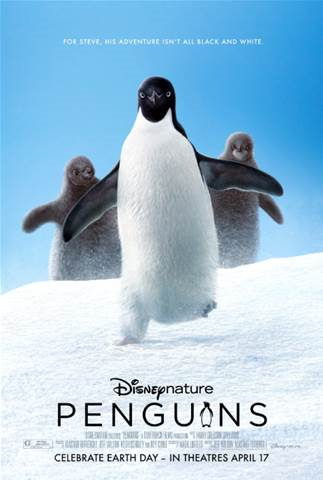

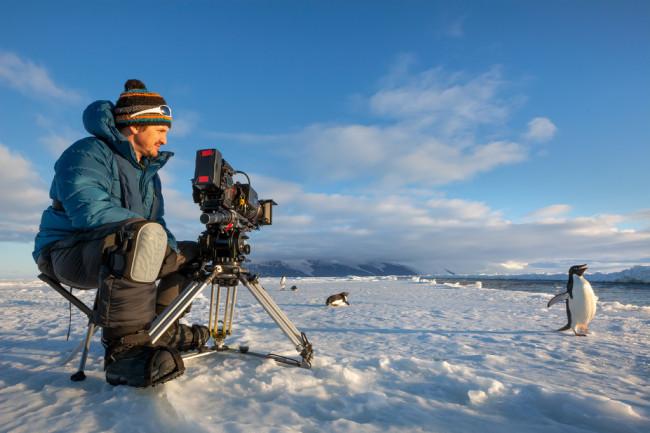
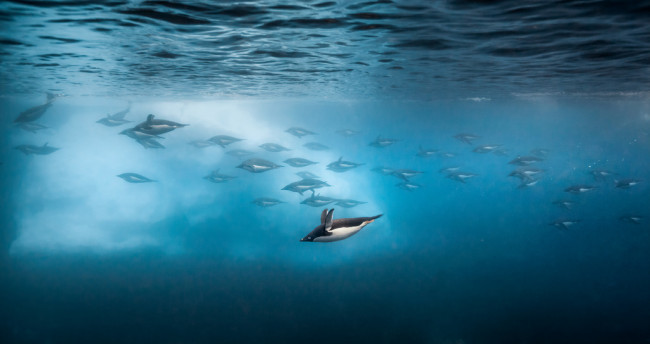
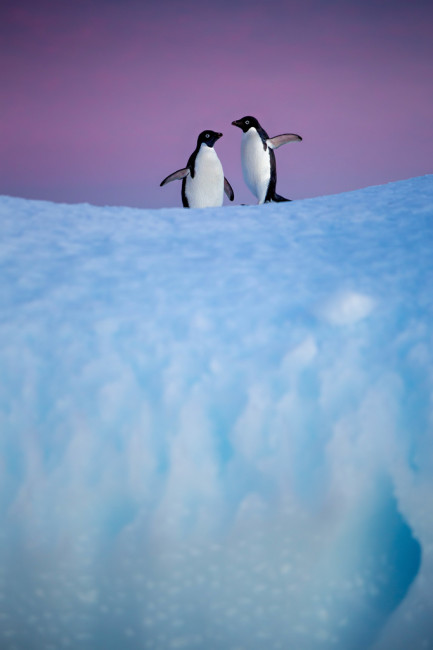
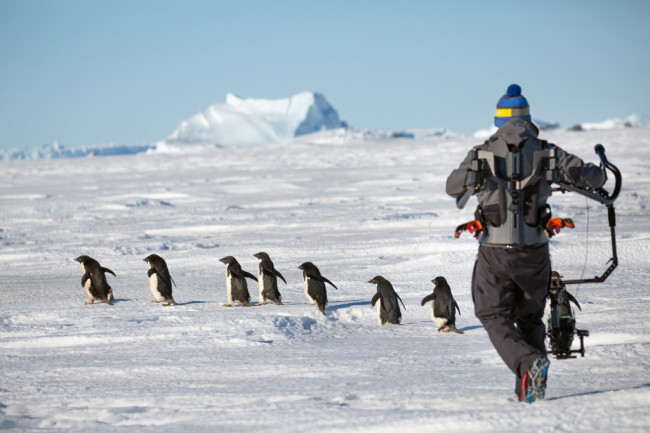
Leave a Reply